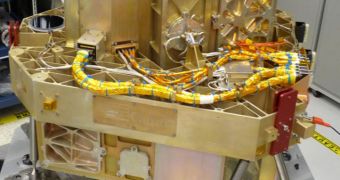Officials at NASA announce that they have received the second of four main flight instruments for the James Webb Space Telescope (JWST). It consists of two separate devices, the Fine Guidance Sensor (FGS) and the Near-Infrared Imager and Slitless Spectrograph (NIRISS).
The agency's next flagship space observatory is currently dues to launch no earlier than 2018, at a cost of roughly $8.8 billion. It will be the most capable, and largest, telescope ever deployed, and will orbit the planet in the L2 Lagrangian point.
FGS/NIRISS arrived in Greenbelt, Maryland, at the NASA Goddard Space Flight Center (GSFC), on July 30. Currently, it is undergoing a series of inspections meant to prepare it for post-delivery testing.
Once this stage is complete, the instrument will be integrated into a platform called the Integrated Science Instrument Module (ISIM), the most important payload on the telescope. The FGS and NIRISS are bundled together as a single instrument, but they perform individual functions.
The purpose of the Fine Guidance Sensor is to point JWST towards its selected targets with maximum accuracy and precision. This will ensure that the JWST will not lose sight of regions of space it's surveilling while it moves through space.
On the other hand, NIRISS will be an extremely-versatile module for astronomical imaging and spectroscopy, which will operate in a wavelength range from 0.8 to 5 micrometers.
It will complement the capabilities of the Mid-Infrared Instrument (MIRI), which was delivered to NASA earlier this year by the consortium of European companies that built it. The device operated in a wavelength range between 5 and 27 micrometers.
NIRISS will operate at roughly the same wavelengths as JWST's infrared imager, the Near InfraRed Camera (NIRCam), which will observe the Universe at ranges between 0.6 and 5 micrometers.
Using this instrument, NASA will be able to detect some of the faintest, coolest and most distant objects that ever existed in the Universe. NIRISS will also be able to see right through the thick clouds of dust surrounding newly-formed stars, and see these celestial bodies as they form.
In addition, it will be able to detect atmospheres around distant extrasolar planets, provided such layers of gas exist. Its amazing capabilities will allow researchers to detect the chemical composition of these atmospheres, and to establish whether they contain life-promoting elements such as oxygen.
“The FGS instrument is part of the integrated control system that performs the extremely fine pointing and stability needed for the Observatory; while the NIRISS instrument will provide great science and new discovery space,” GSFC JWST Instrument Systems Manager, Scott Lambros, says.
“This milestone is the culmination of many years of hard work by our Canadian partners. We have had great cooperation between the FGS team and the Webb telescope team and look forward to continued cooperation integrating the instrument into the ISIM and Observatory,” he adds.
Both FGS and NIRISS were developed under the supervision of the Canadian Space Agency (CSA). The project was led by National Research Council of Canada (NRC) Herzberg Institute of Astrophysics expert, John Hutchings.
“Imagine the challenge at hand here: design and deliver technology capable of unprecedented levels of precision to conduct breakthrough science on board the largest, most complex and most powerful telescope ever built,” concludes CSA President, Steve MacLean.

 14 DAY TRIAL //
14 DAY TRIAL //